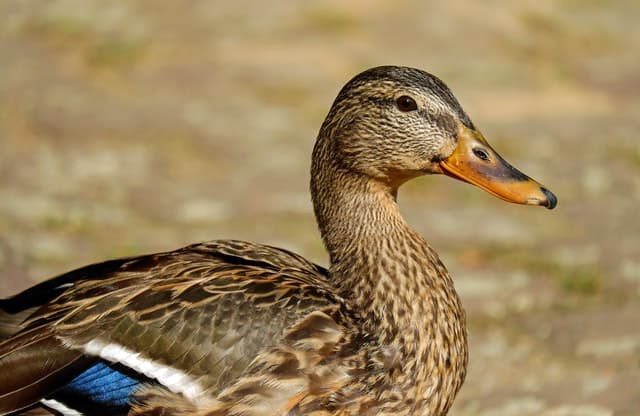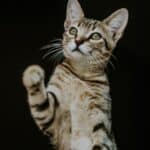
The duck is a docile bird that loves to live in groups with its own kind and that can be easily reared in gardens that have a body of water.
It is a very widespread bird at all latitudes both in the wild and in captivity. The docility, the ease of breeding and the beautiful colored plumage that characterizes certain duck species are, in fact, characteristics that have contributed to its spread as a pet.
The description of the duck
The common name duck is used to identify a large number of anseriform birds belonging to different subfamilies of the anatids sharing the following characteristics:
- wide beak equipped with blades useful for filtering food particles present in the water
- short and webbed legs that allow you to move easily in the water
- ability to deal with long flights
- small size
- migratory habits
- accentuated sexual dimorphism , especially in farmed species, which makes it easy to identify males and females.
The habits of the duck
Ducks have different habits based on their species of affiliation, but some behaviors and character traits are common to all breeds, such as:
- fondness for water
- marked voracity
- need to socialize with their peers
Where the duck lives
It prefers environments where there is water , so it tends to settle near lakes, sea coasts, rivers but also a fountain, a pond or a garden pond . However, it prefers to build a dry nest where the brooding and raising of the offspring takes place.
A feature of several duck species is the migration, even over long distances, to overwinter in warm places.
What the duck eats
The type of feeding of the duck may slightly differ according to the breed and this animal is characterized by a high voracity.
Ducks can find food both on land and in water and feed on insects, small invertebrates, berries and aquatic plants .
Some species of ducks to eat in the water immerse the head, neck and front of the body assuming a funny vertical position, others are able to dive and swim underwater to feed on fish.
If you keep ducks in captivity, their diet should include corn, wheat , oat and bran based feeds that can be purchased at pet stores or online at Amazon.
The reproduction of the duck
Let’s find out all about the reproductive habits of this monogamous palmiped in which the couple is very affectionate.
Duck, when it lays eggs
It begins to lay eggs very young, already from the fourth month of age, and on average it lays 20 eggs 3 times a year. The most prolific species can even lay 100 eggs a year.
The eggs are hatched for about a month only by the mother, who during this period leaves the nest exclusively to get food.
This bird is monogamous for all its life, the mating period is preceded by a complex ritual that begins in spring, towards the month of March, and the young are born in early June.
Duck, where it lays its eggs
The duck builds its nest with sticks of various sizes recovered in the water or along the banks of lakes and rivers. This nest is preferably positioned in areas characterized by a high level of humidity which favors the hatching of the eggs.
Duck and Geese: differences
If you are not an expert on birds, you tend to mistakenly confuse the duck with the geese or use these terms as synonyms although they are not at all.
Ducks and geese are both flown from the webbed legs that live near the water but the former are characterized by small size and high sexual dimorphism while the latter are geese that have not yet reached the reproductive stage. Once the age of maturation is reached, the goose has a decidedly higher size than the duck and the males and females have the same plumage.
The duck as a pet
If you have a garden with a small body of water, the duck can be an alternative pet to cats and dogs
This bird is docile and affectionate, loves socializing, so it is essential to buy at least two specimens and does not scratch like the hen , ruining the gardens. On the contrary, the duck contributes to the destruction of insect larvae such as mosquitoes, flies and ants.
Ducks are very fond of hygiene and spend a good part of the day cleaning their feathers and the nest, at the same time they are robust birds that also tolerate sub-zero temperatures.
Feeding is very simple, just buy specific feed and if you want you can supplement your diet with small pieces of vegetables cut into wedges.
Obviously, as with the adoption of other pets , buying a duck means taking responsibility for its care and well-being by making a commitment to provide for all its material and emotional needs.
You can also keep a duck for ornamental purposes only, therefore, as if it were a companion animal.
Species of ducks
In the Anatidae family there are nearly 150 different species with various characteristics and sizes, including geese and swans. Among the most popular species of domestic ducks are the Mandarin, the suit and the white . These animals are raised for meat or for ornamental purposes, but there are also non-domesticated species among which the most common is the mallard or wild duck .
Mandarin or Peking duck
It is a very common species in China, Russia, Korea and Japan and precisely called Peking duck .
The most famous are certainly Donald Duck, Uncle Scrooge and the whole Disney gang! And in fact they are the classic white ducks, although they have a slight yellowish tinge on the bottom of the feathers, with a yellow beak, long neck, and short red legs. Their wings are of medium length and they fly smoothly. They weigh from 3 to 3.5 kg.
They are very resistant and do not fear harsh climates. Contrary to the so-called ‘mute’, it is a rather noisy species, which can be a problem …
This breed lays 120-180 eggs of white color with brown spots, which have 28 days of incubation. It has a ring diameter of 18 mm.
It is mainly used for its meat.
White duck
This species is similar to that of Peking, but is native to France, in fact its full name is Allier white duck ( Anas platyrhynchos ).
It is characterized by a large size and a completely white plumage and by legs and beak yellow-orange.
Supplanted by the Barbary musk duck, which has a higher yield, it lays 150-180 white eggs per year, but is now bred in the area of the Massif Central from which it originates. It is used only for its meat.
Muscovy or musk duck
The Cairina moschata is a typical species of South America and has white feathers with black spots and, in some cases, red.
It was the Indians who tamed it, but it was the Spaniards who brought it from Brazil to Europe around 1500. Some argue that it was Christopher Columbus.
Also known as Musk Duck or Barbary Duck , it is commonly called Muscovy Duck , In fact it makes no sound except a slight hiss when shaken, accompanied by jerky head movements.
Both the male and the female are identical, characterized by an elongated and broad body, with a long and broad tail. Unlike other duck species, males do not have curved feathers at the tip of their tail.
The legs are sturdy and have hook-shaped nails that can scratch, causing deep injuries even to humans.
The Muscovy duck weighs 4-4.5 kg and is almost 90 cm long.
In nature it tends to nest in a high place to protect itself from predators. It defends itself thanks to powerful claws and good flight quality. In fact it is able to fly and can spend the night perched on the branches if it has the opportunity. It can also nest in sheltered corners such as boxes, hollow trees, open attics.
It can lay about 50 eggs per year, with an incubation period of 35 days, which is longer than other duck species.
Its identification rings have a diameter of 18 mm. In the countryside and in the organic garden it is also useful in the fight against snails .
Wild duck
It is actually the mallard ( Anas platyrhynchos ), characterized by a long and gray body, with a brown-purple chest. It has an iridescent spot bordered with white on its wings and the male, like many ducks, has a tail with the feathers folded upwards.
The head and neck have iridescent green feathers, separated from the chest by a white collar. The beak is large and yellow, with a black tongue at the tip. The eyes are dark. The legs and palms of the feet are orange-red.
It lives in any type of wetland, rivers, ponds, fresh or salt water marshes, estuaries and sometimes even by the sea. However, it needs floating vegetation to search for food, such as seeds, molluscs, insects, small fish, tadpoles, snails and fish eggs.
It is the female who chooses where to nest and usually close to where she was born, or even in the same place. The nest is usually built on the ground, hidden among the grass and reeds or in a hollow in a tree. The female lays 8-10 light green eggs, and hatching occurs after 30 days.
It has a fast flight (it can reach 80 km / h) due to its large size and can fly almost vertically.
This species, like many other ducks, is losing its natural wetland habitat, so it has adapted to live in urban parks and other areas where water is present.
Where to buy a duck
Ducks can be purchased from specialized farms.
Curiosities about the duck
Find out some curiosities about ducks and the idioms in which this cute bird appears.
Does the duck fly?
The flight ability of ducks depends on their species. Ducks belonging to breeds bred in captivity are unable to fly, while the others can take flight.
Why does the duck have webbed legs?
The duck has webbed legs as this feature allows it to move very easily in the water.
What is muscovy duck?
The Muscovy duck is not a bird unable to emit sounds but it is a species native to South America very renowned and prized for the production of meat and eggs.
Why do we say lame duck?
The expression lame duck was born in English journalistic jargon to define a politician who, despite the institutional position held, is unable to exercise his power for various reasons.
What the duck symbolizes
The duck is a bird that assumes positive or negative symbols according to different cultures.
In the East, ducks represent conjugal happiness and fidelity while, often, in the West their flying on the surface of the water recalls a negative symbolism linked to superficiality and deception.
How to draw a duck
Drawing a duck is a very simple operation even for those who do not possess particular artistic skills as long as they follow some simple suggestions:
- draw a small circle for the head and a larger one for the body
- connect the two circles by two inclined curved lines representing the neck
- draw the beak with short straight lines
- trace the stylized paws and then draw triangles to make them webbed
- draw a small eye near the beak
- complete the drawing with all the details that can make your duck even more beautiful and realistic.






